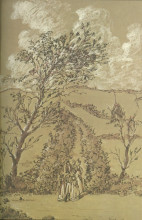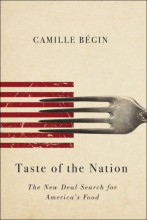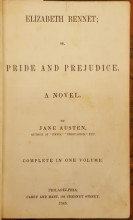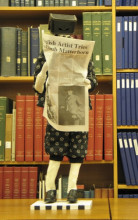Juli McLoone
Posts by Juli McLoone

In honor of the 200th anniversary of Jane Austen’s death, the Nineteenth-Century Forum and the University of Michigan Library are excited to offer a one-day interdisciplinary conference on Friday, January 19, 2018, exploring movement, mapping, and margins within the late-eighteenth and nineteenth centuries. Attendance is free, but we ask that participants register by January 10, 2018, as space for some sessions is limited. A complimentary lunch will be served for those who register.

Please join us on Wednesday, December 13th from 7:00 pm to 8:30 pm at the Ann Arbor District Library (Westgate Branch - West Side Room) for Lights, Camera, Austen: The screen adaptations of Jane Austen.

As Juli McLoone and Sigrid Cordell prepared for The Life and Times of Lizzy Bennet (Nov. 20, 2017-March 30, 2018), a number of Jane Austen's novels were identified as being in need of conservation treatment. These included a two-volume, 1838 edition of The Novels of Jane Austen. These two volumes presented some condition concerns which Cathleen A. Baker Fellow Clara Huisman treated under the supervision of Conservation Librarian/Conservator Marieka Kaye.

Special Collections is pleased to announce the opening of The Life and Times of Lizzy Bennet, a new exhibit in the Audubon Room. This exhibit commemorates the bicentennial of Jane Austen’s death by exploring the historical context in which her characters lived. Join us for the opening celebration next week on Thursday, November 30th, 4:00-6:00pm in the Hatcher Gallery. Light refreshments will be served at 4:00pm and curators Juli McLoone and Sigrid Cordell will begin their lecture at 4:30pm.

Join us at 4pm on Sept. 20 in the Hatcher Gallery. Dr. Camille Bégin, author of Taste of the Nation: The New Deal Search for America’s Food, will shape a cultural and sensory history of New Deal-era eating, illustrating how nostalgia, prescriptive gender ideals, and racial stereotypes shaped how the FWP was able to frame regional food cultures as “American.”

In honor of the 200th anniversary of Jane Austen’s death, the Nineteenth Century Forum and the Special Collections Library at the University of Michigan invite interdisciplinary papers that explore movement, mapping, or the margins within the late-eighteenth or nineteenth centuries. Please email abstracts of no more than 300 words to austenmaps@gmail.com by October 1st 2017. Please also include a paper title, your name, and institutional/departmental affiliation.

Among the author's papers housed in Special Collections are those of U-M alumnus and Ann Arbor native Nancy Willard (1936-2017). Nancy Willard (1936-2017) was born in Ann Arbor and is an alumnus of the University of Michigan and winner of major and minor Hopwood Awards (1955, 1956, 1957, 1958). Although best known as a children’s author and winner winner of the 1982 Newbery Medal for William Blake’s Inn, Willard in fact wrote for a range of audiences and genres.

A quick peek at two cookbooks from the late 1960s, one for Summer of Love hippies and another for their more straight-laced counterparts at home.

Researcher Mark Bocek will join us this Thursday, June 8th at 4:00pm in the Hatcher Gallery for a lecture focusing on actress, puppeteer, and U-M alumna Ellen Van Volkenburg and her role in co-founding Cornish College of the Arts’ Theater Department at Cornish College of the Arts.

The Michigan Theater will be showing Jeremiah Tower: The Last Magnificent next Tuesday, May 30 (4:15pm, 7:00pm, 9:15pm) and Wednesday, May 31 (4:15pm, 7:00pm, 9:15pm). Arrive early, and you may catch a peek at a slideshow of menus from Jeremiah Tower’s personal menu collection, housed here at the University of Michigan Special Collections Library in the Janice Bluestein Longone Culinary Archive.